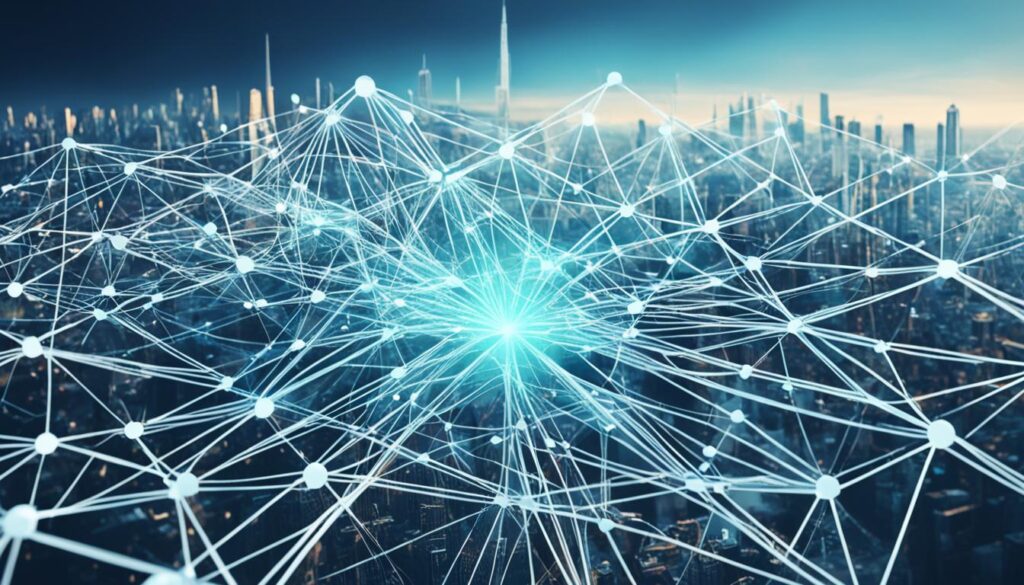Welcome to the future of the internet – Web 3.0, where the possibilities are limitless. In this evolving digital landscape, the decentralized internet takes center stage, offering a range of benefits that will revolutionize the way we interact, transact, and communicate online.
Web 3.0, also known as the decentralized web, goes beyond the traditional internet experience by harnessing innovative technologies such as blockchain, artificial intelligence, and the Internet of Things. These technologies enable intelligent data interpretation, enhance security, and give users greater control over their online presence.
By embracing Web 3.0, individuals and businesses can unlock a world of opportunities. Let’s delve deeper into the benefits of this decentralized internet and gain a better understanding of its potential impact.
Key Takeaways:
- Web 3.0, or the decentralized web, offers a more open, secure, and user-centric digital ecosystem.
- Emerging technologies such as blockchain, AI, and IoT enable intelligent data interpretation and enhanced user experiences.
- The global Web3 market is projected to reach $81.5 billion by 2030, driven by blockchain technology and the Metaverse.
- Decentralization empowers users, enhancing transparency, security, and enabling censorship resistance.
- While Web 3.0 brings exciting possibilities, challenges like complexity, scalability, and regulatory concerns need to be addressed for widespread adoption.
The Rise of Web 3: From Fiction to Reality
Web 3.0, also known as the decentralized web, is not just a concept anymore. It is becoming a reality, thanks to the advancements in emerging technologies like artificial intelligence, machine learning, blockchain, and the Internet of Things.
Web 3.0 takes inspiration from the science fiction dreams of the past and transforms the internet into a smart and interactive network. With the integration of these emerging technologies, Web 3.0 promises a more immersive, decentralized, and secure internet experience.
The power of artificial intelligence and machine learning enables intelligent data interpretation, allowing for personalized and context-aware interactions. Blockchain technology, on the other hand, ensures transparency, security, and trust in a decentralized web environment.
The Internet of Things, with its interconnected devices and sensors, adds another layer of intelligence and automation to Web 3.0. It enables seamless integration and communication between physical and digital entities, creating endless possibilities.
As Web 3.0 continues to evolve, we can expect to see the rise of decentralized applications that offer enhanced user experiences. These decentralized applications, also known as dApps, are built on blockchain technology and enable peer-to-peer interactions without the need for intermediaries.
Moreover, Web 3.0 brings forth the potential for a more inclusive and democratized internet. It enables users to have greater control over their data, ensuring privacy and data ownership. With Web 3.0, individuals become active participants, co-creating the internet and shaping its future.
Web 3.0 is not just a futuristic concept anymore. It is becoming a reality, powered by emerging technologies and driven by the needs and aspirations of internet users. It promises a future where the internet is more intelligent, decentralized, and user-centric.
Stay tuned to explore further sections of our article, where we delve into the market capitalization and growth of Web 3.0, the empowerment it offers to users, the challenges it faces, and the future prospects that lie ahead.

Web 3.0 Market Capitalization and Growth
The Web 3.0 market is experiencing remarkable growth, thanks to the revolutionary potential of blockchain technology, NFTs, and the Metaverse. As a result, the global Web3 market is projected to expand at a staggering average annual rate of 44.6% until 2030, with a total market size estimated to reach $81.5 billion.
Blockchain technology serves as a key catalyst for this projected growth, providing the foundation for decentralized applications and smart contracts that power the Web 3.0 ecosystem. The decentralized nature of blockchain ensures transparency, security, and trust, making it an ideal technology for a decentralized internet.
Additionally, the emergence of non-fungible tokens (NFTs) has captured the imagination of creators, collectors, and investors. NFTs enable the ownership and trading of unique digital assets, from artwork and music to virtual real estate in the Metaverse. The growing popularity of NFTs has further contributed to the expansion of the Web 3.0 market, attracting a wide range of industries and enthusiasts.
The concept of the Metaverse, a virtual universe where individuals can interact using augmented and virtual reality technologies, is another driving force behind the anticipated growth of the Web 3.0 market. As the Metaverse becomes more accessible and immersive, it opens up new avenues for entertainment, commerce, and social interactions, fostering an interconnected digital ecosystem.
Moreover, the increasing awareness and adoption of Web3 technologies across the globe contribute to the market’s rapid expansion. As more individuals and businesses recognize the benefits of a decentralized internet, the demand for Web 3.0 solutions and services continues to grow, creating a thriving global market.
Web3 marketers are actively strategizing and allocating resources to tap into this expanding market. The projected growth and potential opportunities in Web 3.0 have propelled marketers to increase their spending on Web3 marketing initiatives, fueling further innovation and adoption in the industry.
To visualize the growth of the Web 3.0 market, refer to the table below:
| Year | Market Size (in billions USD) |
|---|---|
| 2022 | 30.2 |
| 2025 | 53.7 |
| 2030 | 81.5 |
Note: The table above presents the projected market size of the Web 3.0 industry over the next decade. The numbers are approximate and subject to change based on various factors influencing the market.
The projected growth of the Web 3.0 market presents a myriad of opportunities for individuals, businesses, and industries. By embracing blockchain technology, NFTs, and the Metaverse, stakeholders can position themselves at the forefront of the digital revolution, leveraging the potential of a decentralized internet ecosystem.
Decentralization: Empowering Users in Web 3.0
Web 3.0 brings forth a transformative shift towards decentralization, granting users unprecedented power and control over their online experiences. Unlike the traditional Web 2.0 platforms that concentrate data control in the hands of a select few, the decentralized nature of Web 3.0 ensures a power shift to the masses. This fundamental change is made possible through the innovative implementation of blockchain technology, which facilitates peer-to-peer interactions and enables users to become owners of their data.
Decentralization serves as the bedrock of Web 3.0, fostering a multitude of benefits that enhance the user experience. One such advantage is the heightened transparency offered by decentralized systems. With a distributed network of participants, transactions and operations become transparent to all, preventing the manipulation or censorship of information. This transparency builds trust among users, fostering a more secure and reliable online environment.
“In Web 3.0, users are no longer mere consumers but active participants who shape the digital landscape.”
The decentralized nature of Web 3.0 also bolsters security. By removing the reliance on centralized servers, which are susceptible to cyberattacks and data breaches, users gain greater control over their personal data. This shift empowers individuals to decide how their information is shared, mitigating the risks associated with data misuse.
Censorship resistance is another critical attribute of Web 3.0. By utilizing blockchain technology, which operates on a decentralized network, the power to censor or manipulate content is significantly diminished. This ensures that individuals can freely express their opinions and ideas without fear of suppression or repression.
Overall, the decentralized nature of Web 3.0 paves the way for a more democratic internet, where power is distributed among users. This power shift brings forth a new era of transparency, security, and freedom of expression. As Web 3.0 continues to evolve, individuals have the opportunity to actively participate in shaping the digital world, granting them unprecedented agency and control over their online presence.

Benefits of Decentralization in Web 3.0
| Advantages | Description |
|---|---|
| Transparency | Decentralization ensures that transactions and operations are visible to all participants, fostering trust and preventing manipulation. |
| Security | By removing centralized points of vulnerability, users gain greater control over their data, reducing the risk of cyberattacks and breaches. |
| Censorship Resistance | Decentralized networks make it difficult to censor or manipulate content, allowing for free expression without fear of suppression. |
| User Control | Web 3.0 empowers individuals to have ownership and control over their personal data, dictating how and when it is shared. |
Challenges and Future Prospects of Web 3.0
Despite its promising potential, Web 3.0 also encounters several challenges that warrant attention and resolution. These challenges encompass the complexity of Web 3.0 technologies, scalability limitations, regulatory concerns, user-friendly interfaces, and ethical implications.
Complexity of Web 3.0 Technologies
Web 3.0 introduces a range of technologies such as blockchain, AI, and IoT, which may pose difficulties for both users and developers. The complexity of these technologies requires individuals to invest time and effort in learning and understanding how to effectively engage with the decentralized web.
Scalability Limitations
Scalability remains a critical challenge for Web 3.0 adoption. As blockchain-based systems become more prevalent, the need for efficient scalability solutions becomes apparent. The current limitations in scalability hinder the widespread adoption of Web 3.0 technologies, making it imperative to address this challenge.
Regulatory Concerns
The decentralized and autonomous nature of Web 3.0 raises regulatory concerns, particularly regarding digital identity and data ownership. Striking a balance between innovation and protecting public interests is crucial to address these regulatory challenges and ensure a secure and ethical web environment.
User-Friendly Interfaces
One of the hurdles in the widespread adoption of Web 3.0 is the lack of user-friendly interfaces. The complexity of decentralized applications (dApps) and the overall user experience can deter users from engaging with Web 3.0 platforms. Enhancing user interfaces and providing intuitive experiences will be pivotal in overcoming this obstacle.
Ethical Implications
The integration of AI technologies in Web 3.0 introduces ethical questions that need careful consideration. Issues such as privacy, algorithmic bias, and the responsible use of AI must be addressed to establish trust and ensure the ethical development and deployment of Web 3.0 technologies.
Web 3.0 presents us with both exciting possibilities and significant challenges. As we navigate the complexities of this decentralized era, addressing these challenges will be critical in shaping a future that is both technologically advanced and ethically sound.
To summarize the challenges, here’s a comprehensive table:
| Challenge | Description |
|---|---|
| Complexity of Web 3.0 Technologies | Involves the learning curve for users and developers in understanding and utilizing the technologies that power Web 3.0. |
| Scalability Limitations | Refers to the issues surrounding the ability of Web 3.0 systems to handle a high volume of transactions and users. |
| Regulatory Concerns | Involves finding a balance between innovation and regulation to protect user interests and ensure compliance. |
| User-Friendly Interfaces | Relates to the need for intuitive and engaging interfaces that simplify user interactions with decentralized platforms. |
| Ethical Implications | Encompasses the ethical considerations surrounding data privacy, algorithmic bias, and responsible AI integration in Web 3.0. |

Conclusion
The Web 3.0 revolution brings forth a promising future for the internet, ushering in a new era of decentralized internet benefits and digital innovation. By embracing the decentralized internet, individuals and businesses can tap into intelligent, personalized experiences that enable greater control and empowerment.
Understanding the potential of Web 3.0 is crucial in staying informed about the latest developments and unlocking opportunities for growth. This revolutionary concept offers a more transparent, secure, and user-centric digital ecosystem.
While there are challenges to overcome, such as complexity and scalability, the impact of Web 3.0 on various industries and the digital economy makes it an area worth exploring. By embracing the decentralized internet revolution and embracing Web 3.0, individuals and businesses can thrive in this evolving landscape. It’s time to embrace the future of digital innovation and pave the way for a truly transformative internet experience.
FAQ
What is Web 3.0?
Web 3.0, also known as the decentralized web, is the next phase of the internet’s evolution. It aims to create a more open, secure, and user-centric digital ecosystem.
What technologies are used in Web 3.0?
Web 3.0 utilizes technologies such as blockchain, artificial intelligence, and the Internet of Things to enable intelligent data interpretation and facilitate peer-to-peer interactions.
What are the benefits of Web 3.0?
Web 3.0 offers benefits such as enhanced transparency, security, and user control. It shifts power from centralized entities to the masses and provides a more immersive and personalized internet experience.
What is the projected growth of the Web 3.0 market?
The global Web3 market is projected to continue growing at an average annual rate of 44.6% until 2030, reaching a total market size of $81.5 billion. This growth is attributed to the increasing adoption and implementation of blockchain technology, NFTs, and the Metaverse.
How does Web 3.0 empower users?
Web 3.0’s decentralized nature empowers users to have greater control over their information. It enhances transparency, security, and censorship resistance by distributing data control among the users.
What are the challenges of Web 3.0?
The challenges of Web 3.0 include the complexity of its technologies, scalability issues with blockchain-based systems, regulatory concerns regarding digital identity and data ownership, lack of user-friendly interfaces, and ethical questions related to AI integration.
Why should I embrace the decentralized internet revolution?
Embracing the decentralized internet revolution and understanding Web 3.0 is crucial in staying informed about the latest developments and unlocking the opportunities it offers. It ensures individuals and businesses can thrive in this new era of digital innovation.








